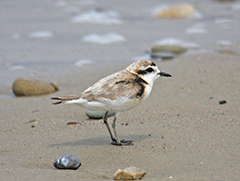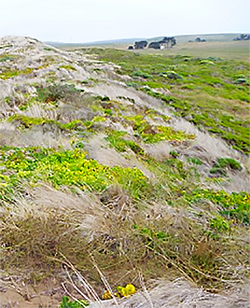
Native to the California coast and the California/Nevada state line, the Myrtle’s silverspot butterfly feeds on the nectar of the monardella flowers.

One of 33 species of birds listed as threatened or endangered by the State of California or the federal government, the western snowy plover is in jeopardy of disappearing from the dunes.

in 2017, two years after treatment, the southwest side of the herbicide treatment area shows little regrowth of invasive plants.
Sandy dunes along the California coast often feature hardy European beachgrass and a succulent, freeway iceplant, that many assume is part of the native flora. However, these groundcover plants were originally introduced in the 1800s by Gold Rush settlers who were hoping to keep sand from moving to the nearby roads, railroads and land. Today, they are invasive species that out-compete the native plants and the animals that live there.
Over the years, the invasives took over the native Tidestrom lupine and beach layia, causing them to be placed on the federally endangered species list. The endangered Myrtle’s silverspot butterfly and the threatened snowy plover are dependent on native plants like these, and today, they too are in jeopardy of disappearing from the area.
“Snowy plovers naturally select open areas to nest so that they can more easily spot predators,” said CDFW Environmental Scientist Laird Henkel. “The European beachgrass spreads quickly making the dunes less desirable as a place for these birds to nest.”
Scientists determined that removing these invasive plants would be the best way to restore the dunes and the ecosystem that depends on them. To this end, CDFW awarded $54,000 in Environmental Enhancement funds to a project on the Point Reyes North Great Beach, located in Marin County, to restore the native sand dune plants on a 13-acre area in 2015. The fund committee selected the Point Reyes application because of the success of their previous dune restoration projects.
Point Reyes National Seashore staff oversaw the removal of the invasive plants on the dunes. Their contractors spray-treated the dunes with an herbicide and uprooted the invasives by hand; they worked during times of low winds and no rain, to protect other natural plants, wildlife, nearby farms and the public from overspray.
Point Reyes scientists monitored the treated area with an easy-to-use mapping tool called photo point monitoring – an effective method of monitoring vegetation and ecosystem change. Visual surveys and the mapping program showed just a one-to-three percent regrowth of the invasive plants over time, while previous restoration projects showed much more regrowth.
“The project area represents a vital link between earlier restoration efforts near Abbotts Lagoon and new restoration efforts at the AT&T cell tower area, enabling the park to move closer towards its goal of several miles of dune habitat not wiped out by invasive plants such as European beachgrass and iceplant,” said Point Reyes National Seashore Ecologist Lorraine Parsons.
CDFW-OSPR and the Point Reyes staff consider the project’s first objective – eradicating invasive European beachgrass and ice plant – a success. Earlier this year, scientists noticed in treated areas the reappearance of wild cucumber. The reappearance of other native plants such as the mock heather, California blackberry and yarrow, and wildlife is the second objective, the success of which will be determined over time. Other treated areas in the region show beachgrass breakdown and increased native dune scrub and mat species after six years.
Photos courtesy of Point Reyes National Seashore and the U.S. Fish and Wildlife Service.
Top photo: The Point Reyes National Seashore staff oversee contractors spray-treating the dunes with an herbicide.